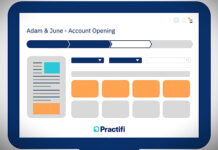By Adrian Johnstone, Practifi
Financial planning and wealth management are based on trust, where the quality of each client relationship is essential to your continued success as a financial advisor.
Fortunately, there’s no complex secret behind building a rewarding and lasting client relationship. As long as you embrace reliable and sensible best practices, aided by the latest and greatest in financial planning technology, great connections with your clients can become a natural part of your work routine.
The following are four areas you can focus on in your dealings with clients. Some deal with your face-to-face meetings, while others are more rooted in the work you perform behind the scenes.
When combined, these practices create a 360-degree approach to positive client relationship development, one that can serve you well for years to come.
1. Build trust as soon as possible
Your relationship with a new client will naturally grow and change over time — but if you make a bad first impression, that process may never get the chance to happen. This is not meant to intimidate you or put undue pressure on your first meetings with clients. Rather, it’s a simple reminder to lean on best practices and reliable strategies from the very beginning.
To create a positive impression, it pays to be methodical and on the ball before your first meeting with a client even begins. The Street recommends sending out the checklist of your firm’s needs in advance. This will not only help the client come in with plenty of necessary information, it also reassures them that your firm is competent and process-driven.
Before a detailed financial plan comes together, you should take the time to ensure you and the client are on the same page about everything from communication preferences to long-term goals. The Street added that it pays to introduce other members of your firm early in the relationship. This will help the overall connection between business and client, as it increases the comfort level in dealing with the firm when you are not personally available.
2. Learn to truly understand client needs
Understanding what clients require from you and your firm is a top priority. Unfortunately, the most obvious approach to learning these details, just asking, doesn’t always tell the whole story. NASDAQ revealed that there is sometimes a disconnect between clients’ views of their goals and the way advisors see things.
The Financial group of Philadelphia’s Paul Bufty told NASDAQ that it’s important to learn a client’s “story” rather than just grasping the basics of their investing goals. Lending a thoughtful ear to a client’s experiences and the reasons why they hold their views and values regarding investment can help you make a financial plan.
In addition to the interpersonal dimension, there is a technological side to learning about your clients’ needs. If you have a customer relationship management (CRM) platform that enables you to create in-depth profiles of your clients, you can keep track of data points from questionnaires, as well as biographical details they have shared with you.
A CRM tool is a perfect addition to your client fact-finding because it can go beyond the spreadsheets and numbers to incorporate the more human side of investment and wealth management. It’s even better if that CRM system has smooth integration with your firm’s financial software platform, as the numbers and the added details can coexist, creating a more complete picture of what your clients want, need and value.
3. Develop a financial plan that delivers
Creating a financial plan that meets your clients’ goals means delivering different outcomes for each particular person. The range of objectives and goals held by individuals tends to differ based on personal factors, including the overall value of their investable assets.
The most recent research from Securities Industry and Financial Markets Association and Cerulli Associates breaks down top goals by clients’ levels of wealth. Households with under $100,000 in assets, for instance, are most interested in strategies that will improve their cash flow, while those with more than that are focused on ensuring they will be comfortable in retirement.
Strategies for aggressive wealth growth are most popular among people with under $100,000, while those with more than $1 million to invest are naturally more occupied with protecting their present level of wealth.
While these breakdowns by funds are somewhat instructive as a starting point, it still pays to learn as much as possible about your customers on an individual level. Among people with under $100,000 to invest, for example, 12% are interested in aggressive wealth expansion while 10% are most concerned with saving for their family members’ college education. Knowing where your clients fall on these issues can help you fine-tune each financial plan.
4. Maintain the financial advisor and client relationship over time
As with any interpersonal relationship worth keeping, your connection with your clients should be cared for over time. It pays to speak with your clients on a more personal basis.
Hartford Funds’ Julie Genjac told U.S. News and World Report about the power of taking the initiative and calling clients directly, even when it’s not time for a scheduled meeting. Speaking to a person “just because” is a way to maintain their trust and reassure them that they — and their investments — are on your mind, even when there is not any major activity with the account.
Client appreciation events are another potential pillar of good ongoing relationships, U.S. News added. While the in-person components of these gatherings closed down due to COVID-19, creative advisory firms kept them going virtually, and they can be an important part of planning for the future. These low-stress events can add some extra human contact to the client-advisor relationship, making a contrast with business-first meetings.
To keep up a good cadence of client communications, you can turn again to your CRM tool. These solutions are at their best when integrated with marketing tools, calendars and more. can You can make sure you’ll have an email ready to go or a video meeting booked at times that match up with your clients’ preferred frequency.
Adding an element of automation to client contact allows you to stay on top of multiple relationships, avoiding lapses in communication that may lead to people feeling ignored. While the actual messages you send in your meetings and emails should connect with your clients on a personal level, scheduling outreach is best handled by technology.
Thrive in the interpersonal side of your business
Cultivating your clients’ trust is such an important objective that it touches all corners of your financial advisory practice. From designing each individual financial plan to maintaining contact outside of regularly scheduled meetings, there are plenty of ways to subtly but meaningfully enhance the client experience.







